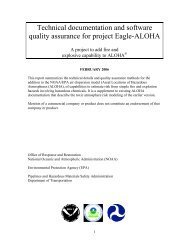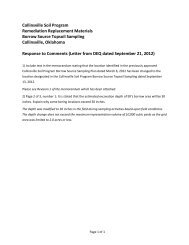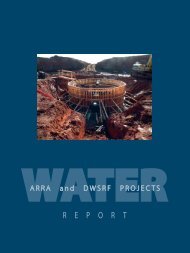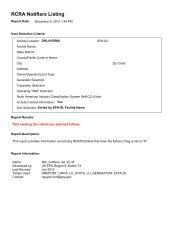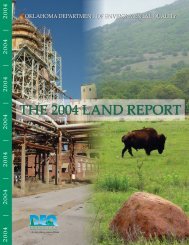Oklahoma Gas & Electric Muskogee Generating Station Best ...
Oklahoma Gas & Electric Muskogee Generating Station Best ...
Oklahoma Gas & Electric Muskogee Generating Station Best ...
You also want an ePaper? Increase the reach of your titles
YUMPU automatically turns print PDFs into web optimized ePapers that Google loves.
<strong>Oklahoma</strong> <strong>Gas</strong> & <strong>Electric</strong><br />
<strong>Muskogee</strong> <strong>Generating</strong> <strong>Station</strong> – BART Determination<br />
May 28, 2008<br />
dry by-product. The process equipment associated with a spray dryer typically includes an<br />
alkaline storage tank, mixing and feed tanks, an atomizer, spray chamber, particulate<br />
control device and a recycle system. The recycle system collects solid reaction products<br />
and recycles them back to the spray dryer feed system to reduce alkaline sorbent use.<br />
Various process parameters affect the efficiency of the SDA process including: the type and<br />
quality of the additive used for the reactant, reactant stoichiometric ratio, how close the<br />
SDA is operated to saturation conditions, and the amount of solids product recycled to the<br />
atomizer. The control efficiency of a SDA system is limited to approximately 94% of the<br />
SO2 loading to the system, and is a function of numerous operating variables including gasto-liquid<br />
contact and system operating temperatures.<br />
In a dry FGD system, the amount of reactant slurry introduced to the spray dryer must be<br />
controlled to insure that the reaction products leaving the absorber vessel are dry.<br />
Therefore, the outlet temperature from the absorber must be maintained above the<br />
saturation temperature. SDA systems are typically designed to operate within<br />
approximately 30 o F adiabatic approach to the saturation temperature. Operating closer to<br />
the adiabatic saturation temperature allows higher SO2 control efficiencies; however, outlet<br />
temperatures too close to the saturation temperature will result in severe operating<br />
problems including reactant build-up in the absorber modules, blinding of the fabric filter<br />
bags, and corrosion in the fabric filter and ductwork.<br />
High SO2 removal efficiencies in a SDA are also dependent upon good gas-to-liquid<br />
contact. Reactant spray nozzle designs are vendor-specific; however, both dual-fluid<br />
nozzles and rotary atomizers have been used in large coal-fired boiler applications.<br />
Dual-fluid nozzles (slurry and atomizing air) typically consist of a stainless steel head with<br />
multiple, ceramic two-fluid nozzle inserts. Slurry enters through the nozzle head and is<br />
distributed to the nozzle inserts. Atomizing air enters concentrically into a reservoir in the<br />
nozzle head and mixes with the slurry. The atomizing air expands as it passes through the<br />
air holes and nozzle exit. This expansion creates the shear necessary to atomize the slurry.<br />
Each nozzle is provided with a feed lance assembly consisting of a concentric feed pipe (air<br />
around slurry), hose connections, and the nozzle head. The feed lance assembly is inserted<br />
down through the SDA roof through a nozzle shroud assembly.<br />
Rotary atomizers are comprised basically of a high-speed rotating atomizer wheel coupled<br />
to a drive device and speed-increasing gear box. Because the reactant slurry is abrasive, the<br />
atomizing nozzles typically consist of a stainless steel head and multiple abrasion-resistant<br />
45



